





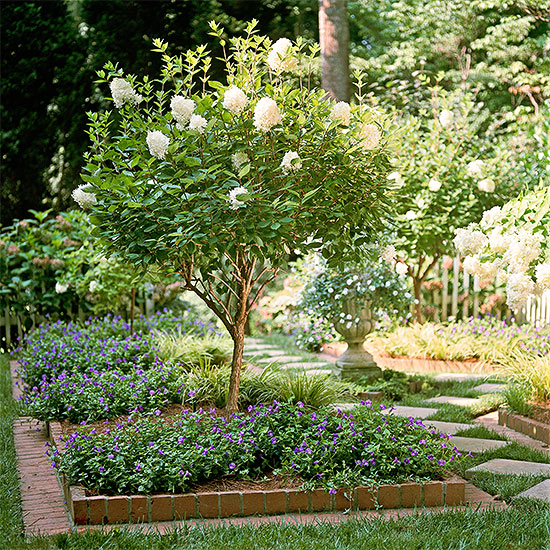
While most hydrangeas do best in shade, varieties of Hydrangea paniculata prefer sunny spots. Most selections have large clusters of white flowers in summer. The showy blooms fade to shades of pink or red before drying to beige. In many areas, they dry right on the plant in fall and stay looking good through most of the winter.
Learn more about specific hydrangeas in our Plant Encyclopedia.
Growing
While Hydrangea paniculata likes full sun, it also does well in part shade. It prefers moist, well-drained soil rich in organic matter, so it's helpful to amend your soil with compost, peat moss, or other similar materials before you plant it. Hydrangea paniculata is one of the hardiest varieties; it thrives in Zones 4-8.
Pruning
Because this hydrangea blooms on current year's growth, the best time to give it a trim is winter or early spring.
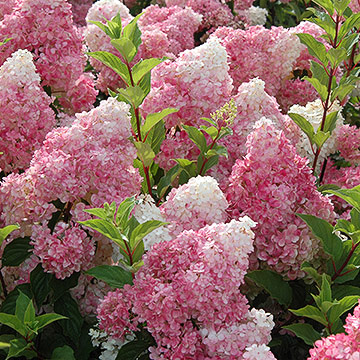 Vanilla Strawberry Hydrangea
Vanilla Strawberry Hydrangea
Standout Varieties
Hydrangea paniculata 'Bombshell' is a dwarf selection that grows 3 feet tall and 4 feet wide. It bears clusters of white flowers from midsummer to autumn.
Hydrangea paniculata 'Grandiflora' is sometimes called peegee hydrangea. It's a large shrub or small tree to 20 feet tall.
Hydrangea paniculata 'Limelight' bears light lime-green flowers from midsummer to fall. It grows 8 feet tall.
Vanilla Strawberry Hydrangea paniculata 'Rehny' bears large clusters of white flowers that fade to strawberry pink from midsummer to autumn. It grows 7 feet tall.
Learn more about Vanilla Strawberry hydrangea.
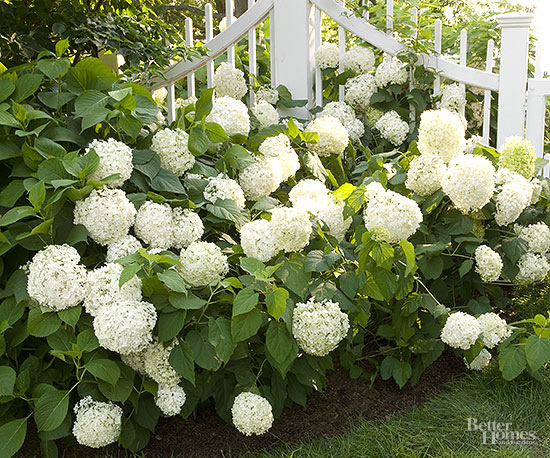 Annabelle Hydrangea
Annabelle Hydrangea
Smooth hydrangea (Hydrangea arborescens), also sometimes called hills of snow or snowball hydrangea, is an especially easy-growing type that's native to areas of North America. It has clusters of pure white flowers from midsummer into autumn; the older flowers often fade to green before they turn brown and dry.
Growing
Grow smooth hydrangea in part shade and moist soil that's rich in organic matter. It's not very drought tolerant, especially if it's in a spot that gets afternoon sun -- so be sure to water it during dry spells and apply a 2- to 4-inch-deep layer of mulch on the soil. This extra-hardy hydrangea thrives in Zones 3-9.
Pruning
Smooth hydrangea blooms on new growth, so if you need to prune it, the best time is in winter or early spring. Some gardeners cut it back to 6 or 8 inches tall every year to keep it dense and compact.
Standout Varieties
Hydrangea arborescens 'Annabelle' bears extra-large clusters of white flowers. It grows 5 feet tall.
Hydrangea arborescens 'White Dome' bears fluffy clusters of creamy-white flowers. It grows 6 feet tall and is hardy in Zones 4-9.
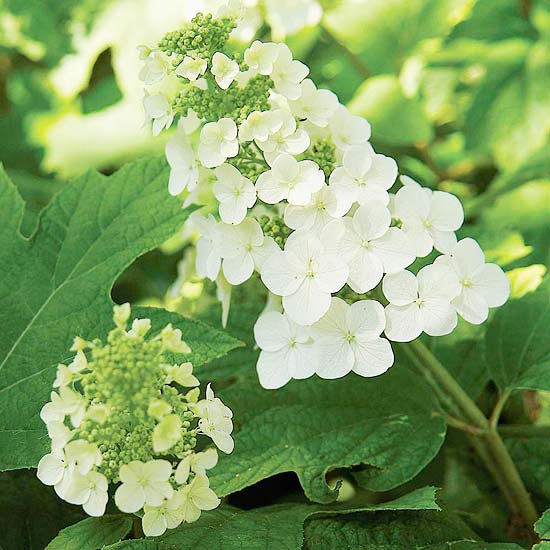 Oakleaf Hydrangea
Oakleaf Hydrangea
Majestic oakleaf hydrangea is one of the easiest types to grow. It's also one of the showiest thanks to its big clusters of white summertime flowers, attractive peeling bark, and textured foliage that turns brilliant shades of purple-red in fall. Oakleaf hydrangea can be a big shrub (it grows 8 feet tall) that's great for providing summertime privacy or as a backdrop in the shade garden. Like smooth hydrangea, it's native to areas of North America.
Growing
Give oakleaf hydrangea a spot in shade or partial shade and moist, well-drained soil. It stands up to dry soil a bit better than most other types, but still appreciates moisture during drought. Like any other hydrangea, it will perform best if there's a lot of organic matter in the soil. Oakleaf hydrangea is hardy in Zones 5-9.
Pruning
Oakleaf hydrangeas bloom on last year's branches, so the best time to prune them is right after the flowers fade in late summer. Because the bark is interesting as it matures, many gardeners do not prune their oakleaf types.
Standout Varieties
Hydrangea quercifolia 'Alice' offers extra-large blooms and more spectacular fall color. It grows 10 feet tall.
Hydrangea quercifolia 'Little Honey' shows golden-yellow foliage and clusters of white summertime flowers. It grows 4 feet tall.
Hydrangea quercifolia 'Snowflake' bears clusters of double white flowers. It grows 8 feet tall.
Hydrangea quercifolia 'Vaughn's Lillie' displays spectacularly dense clusters of white flowers. It grows 4 feet tall.
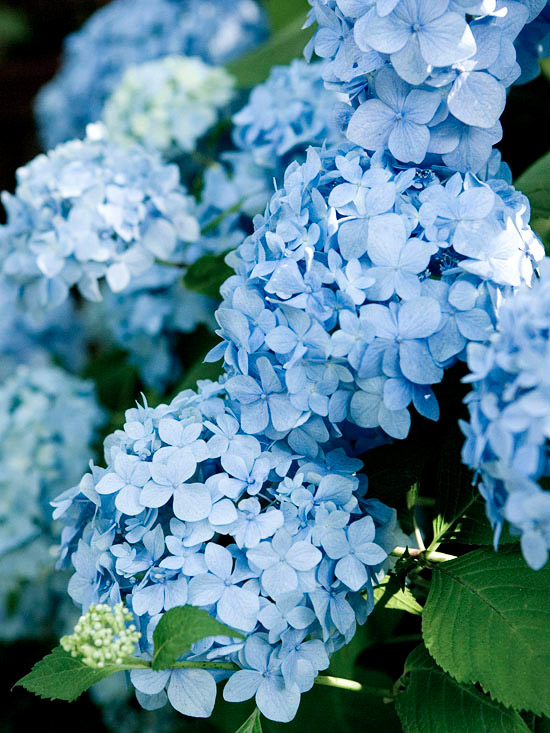 Endless Summer Hydrangea
Endless Summer Hydrangea
It used to be that the beautiful blue- and pink-blooming hydrangeas would bloom once a year, usually in June. But plant breeders have been hard at work, and their efforts are paying off in a new type of hydrangea: rebloomers. Series such as Endless Summer and Let's Dance offer big, colorful blooms every few weeks in summer and fall. Many of these varieties offer beautiful fall color.
Growing
Reblooming hydrangeas do best in a spot that gets morning sun and afternoon shade. Like other hydrangeas, they prefer moist, well-drained soil that has a lot of organic matter in it. The plants aren't very drought tolerant, so you'll probably need to water them during dry spells.
Here's a hint: The level of acidity in the soil affects the flower color of blue and pink varieties. The more acidic the soil is, the bluer the flowers will be; the less acidic, the pinker the flowers will be. Add soil sulfur or aluminum sulfate for bluer flowers and add dolomitic lime for pinker flowers. Both of these products are available from your local garden center -- read the packaging directions to determine how much of the product to use in your garden.
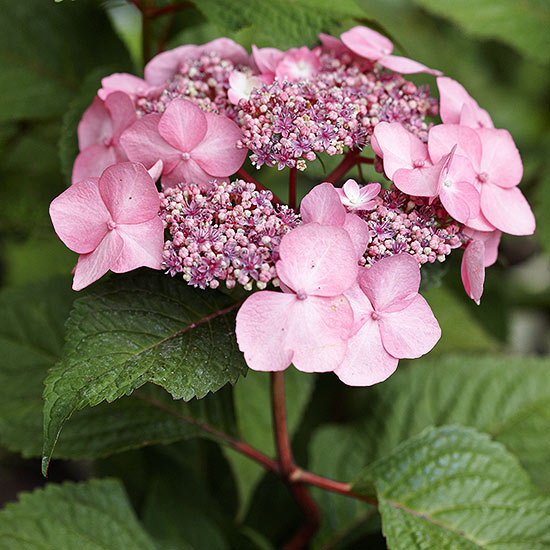 Twist-n-Shout Hydrangea
Twist-n-Shout Hydrangea
Pruning
Rebloomers produce blossoms on both last year's branches and this year's stems, so you can prune them at any time without significantly affecting their flowering cycle. Many gardeners find the plants grow and bloom best if they only cut off parts of branches that died over winter.
Encourage your hydrangea to produce more blossoms by cutting off the flower heads as they start to fade.
Standout Varieties
Hydrangea macrophylla Endless Summer bears mophead clusters of pink or blue flowers. It grows 5 feet tall. Zones 4-9
Hydrangea macrophylla Endless Summer Blushing Bride bears white flowers flushed with light pink. It grows 5 feet tall. Zones 5-9
Hydrangea macrophylla Endless Summer Twist-n-Shout bears blue or pink lacecap-type flowers. It grows 5 feet tall. Zones 4-9
Hydrangea macrophylla Let's Dance Moonlight bears rich blue or pink mophead-type flowers. It grows 5 feet tall. Zones 5-9
Hydrangea macrophylla Let's Dance Starlight bears rich blue or pink lacecap-type flowers. It grows 5 feet tall. Zones 5-9
Hydrangea macrophylla Mini Penny bears blue or pink mophead-type flowers. It grows 4 feet tall. Zones 5-9
Hydrangea macrophylla Penny Mac bears blue or pink mophead-type flowers. It grows 6 feet tall. Zones 5-9
Learn about Wedding Gown hydrangea, a double reblooming lacecap.
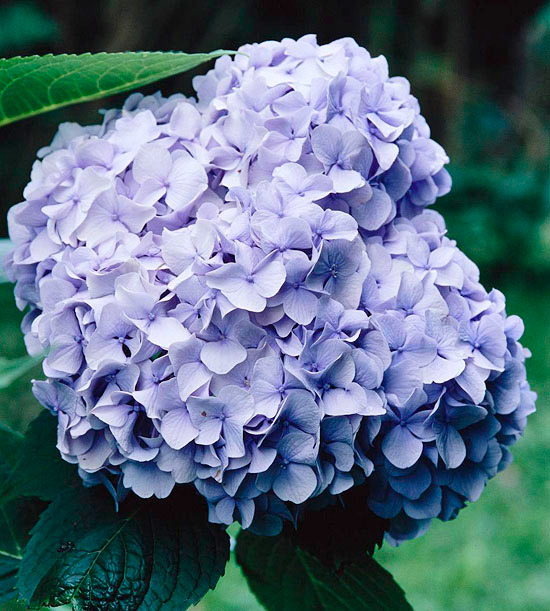 Big Daddy Hydrangea
Big Daddy Hydrangea
Mophead-type hydrangeas -- the ones with the big, puffy balls of flowers -- lend a grace and old-fashioned elegance to the garden. They're beautiful cut flowers and dry well, too. Many offer outstanding fall color, to boot. Most mopheads bloom in June and July on last year's branches. This makes the plants susceptible to winter damage (the flower buds freeze and die). Late-spring frosts can also kill buds before they open.
Growing
Mophead hydrangeas typically thrive in morning sun and afternoon shade. They prefer moist, well-drained soil that's full of organic matter. Keep them looking good by watering them during periods of drought. Otherwise the leaves may turn brown and crispy.
Here's a hint: Like many other blue or pink hydrangeas, the soil pH will make the blooms appear more blue or pink. The more acidic the soil is, the bluer the flowers will be; the more alkaline it is, the pinker the flowers will be. Use soil sulfur or aluminum sulfate to make the soil acidic for blue flowers or add dolomitic lime for pinker flowers. Look for these products at your local garden center. Read the packaging directions to determine how much of the product to use in your garden.
Pruning
Because these hydrangeas bloom only once a year, the best time to prune them is right after they finish flowering. By late summer they've already started making next year's blooms.
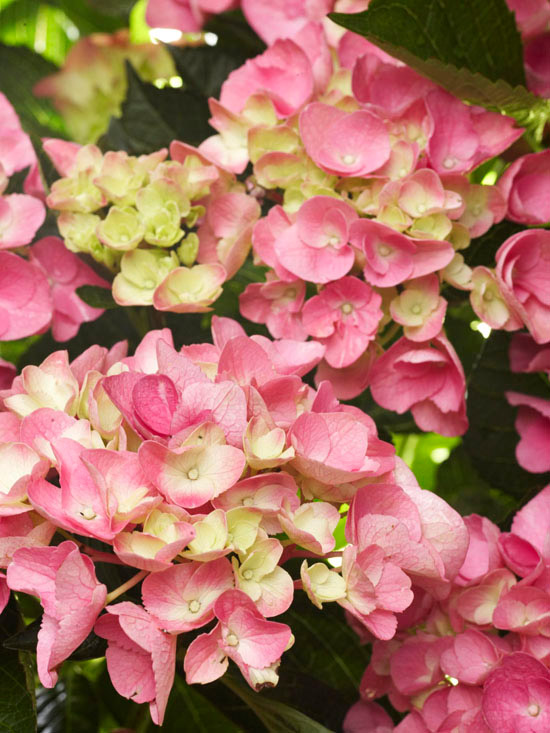 Cityline Hydrangea
Cityline Hydrangea
Standout Varieties
Hydrangea macrophylla Big Daddy produces huge clusters of blue or pink flowers. It grows 5 feet tall. Zones 6-9
Hydrangea macrophylla Buttons 'n' Bows bears clusters of pink or lavender-blue flowers edged in white. It grows 4 feet tall. Zones 6-9
Hydrangea macrophylla Cityline Venice displays clusters of bright pink or lavender-blue flowers on strong stems. It grows 4 feet tall. Zones 6-9
Hydrangea macrophylla Color Fantasy shows clusters of rich red flowers over shiny, dark green foliage. It grows 3 feet tall. Zones 5-9
Hydrangea macrophylla Forever Pink offers clusters of rich pink or lavender-blue flowers. It grows 3 feet tall. Zones 6-9
Hydrangea macrophylla Lemon Daddy has golden-yellow foliage and clusters of blue or pink flowers. It grows 4 feet tall. Zones 5-9
Hydrangea macrophylla Nikko Blue offers clusters of rich blue or pink flowers. It grows 6 feet tall. Zones 6-9
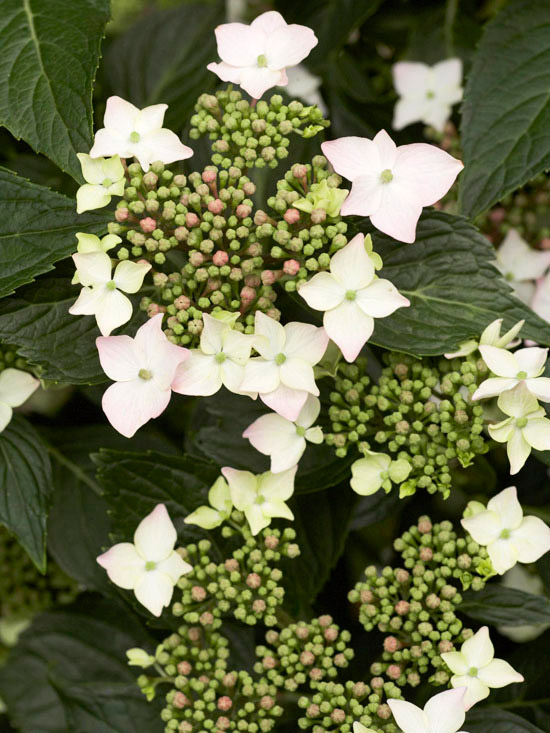 Bits of Lace Hydrangea
Bits of Lace Hydrangea
These beautiful hydrangeas have a more refined appearance -- they have a cluster of tiny blooms ringed by starry, bigger ones. Like mopheads, they bear flowers on last year's branches and are also good picks for adding fall color to the garden.
Growing
Lacecap hydrangeas prefer morning sun and afternoon shade. They like moist, well-drained soil rich in organic matter. Water them during dry spells to keep them looking good, otherwise their leaves may turn dry and brown.
Here's a hint: You can influence the bloom color of blue and pink lacecap varieties by changing the pH of your soil. Acidic soil creates blue flowers; alkaline ground makes the flowers pink. Use soil sulfur or aluminum sulfate to make the soil acidic or add dolomitic lime to make it more alkaline. Find these products at your local garden center and read the instructions on their packaging to determine how much to use in your garden.
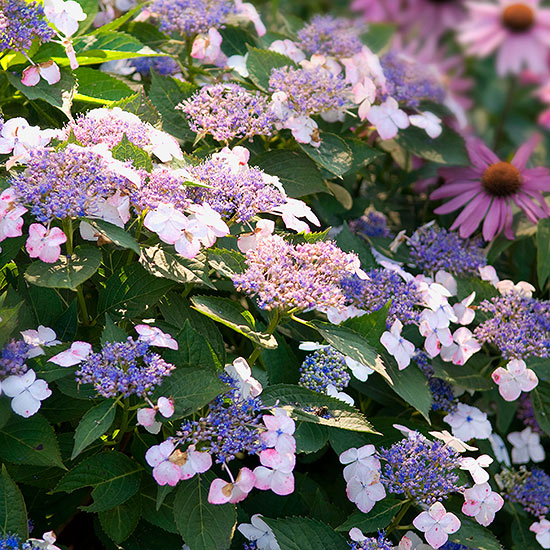 Mariesii Perfecta Hydrangea
Mariesii Perfecta Hydrangea
Standout Varieties
Hydrangea macrophylla Bits of Lace produces pale pink flowers on a 5-foot-tall shrub. Zones 6-9
Hydrangea macrophylla Lady in Red offers red flowers, burgundy stems, and beautiful purple-red fall color. It grows 5 feet tall. Zones 5-9
Hydrangea macrophylla Lanarth White bears white flowers on a compact, 3-foot-tall shrub. Zones 6-9
Hydrangea macrophylla Lemon Wave offers foliage boldly edged in cream, white, and yellow. The blooms are light blue or pink. It grows 6 feet tall. Zones 6-9
Hydrangea macrophylla Mariesii displays pink or blue flowers over white-edged leaves. It grows 5 feet tall. Zones 6-9
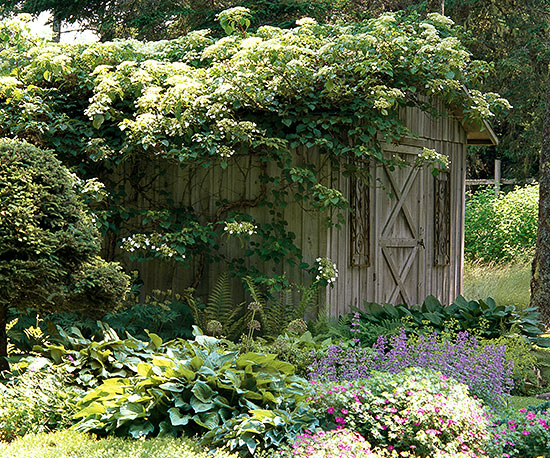 Climbing Hydrangea
Climbing Hydrangea
The most majestic member of the clan, climbing hydrangea is a slow-growing vine that matures at about 50 feet. In summer, it bears lacecap-like clusters of white flowers over its rich green foliage.
Growing
Give climbing hydrangea a spot in part to full shade and a sturdy support to climb on. This vine is great at scaling walls and other structures because roots grow from the stems and cling to a surface. Be sure to give climbing hydrangea moist, well-drained soil that has a high organic matter content.
Here's a hint: Be patient. Climbing hydrangeas are notorious for taking a few years to get established. It may not appear to grow at all for three or four years. But when it does, it more than makes up for it.
Pruning
This hydrangea typically doesn't need pruning. Remove wayward shoots any time between winter and midsummer.
Standout Varieties
Hydrangea petiolaris 'Firefly' bears green leaves edged in gold and clusters of white flowers. Zones 4-8
Hydrangea petiolaris 'Kuga Variegated' displays green leaves stippled in cream and gold. Zones 5-7
Hydrangea petiolaris 'Skylands Giant' bears extra large flower clusters. Zones 4-8
Discover other hydrangea varieties in our Plant Encyclopedia.
Choosing The Best Flowers For Your Indoor Garden
Pick the Best Roses for Your Garden
Designing the Flower Garden of Your Dreams
Choosing The Best Plants For Your Garden
Ideas for Your Roof Top Garden
Pergola Designs - How to Choose the Right Style for Your Garden
How to Choose the Right Container Garden Plants for Your Home
Copyright © www.100flowers.win Botanic Garden All Rights Reserved